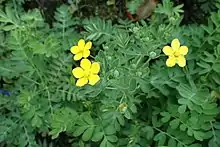| Sibbaldianthe bifurca | |
|---|---|
 | |
| Scientific classification | |
| Kingdom: | Plantae |
| Clade: | Tracheophytes |
| Clade: | Angiosperms |
| Clade: | Eudicots |
| Clade: | Rosids |
| Order: | Rosales |
| Family: | Rosaceae |
| Genus: | Sibbaldianthe |
| Species: | S. bifurca |
| Binomial name | |
| Sibbaldianthe bifurca (L.) Kurtto & T.Erikss. | |
| Synonyms | |
|
Potentilla bifurca L. | |
Sibbaldianthe bifurca is a species of flowering plant in the family Rosaceae which can be found in the steppes, grasslands and various slopes of Russia, Korea, and Mongolia at an elevation of 400–4,000 metres (1,300–13,100 ft). It is also found on sandy coasts of North and Northeast China. It was described by Carl Linnaeus in 1753 in his book Species Plantarum as Potentilla bifurca.[1]
Description
The species is 5–20 centimetres (2–8 in) tall and have 3–8 pairs of leaflets which are elliptic, obovate, sessile, and are 0.5–1.5 centimetres (0.2–0.6 in) by 4–8 millimetres (0.2–0.3 in). The leaves are 3–8 centimetres (1.2–3.1 in) long with membranous and brown coloured stipules. Flowers are as tall as 0.7–1.5 centimetres (0.3–0.6 in) while the sepals are ovate and the apex is acute. It petals are yellow in colour and are obovate with rounded apex. the ovary is pilose white the achenes are smooth. Both flowers and fruits bloom from May to October.[1]
References
- 1 2 "Potentilla bifurca". 9: 294.
{{cite journal}}: Cite journal requires|journal=(help)
Further reading
Carl Linnaeus (1753). Species Plantarum. Vol. 1. p. 497.